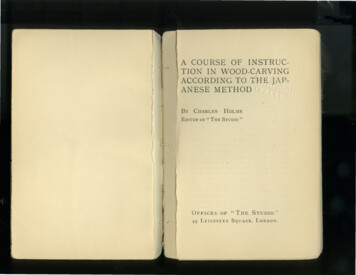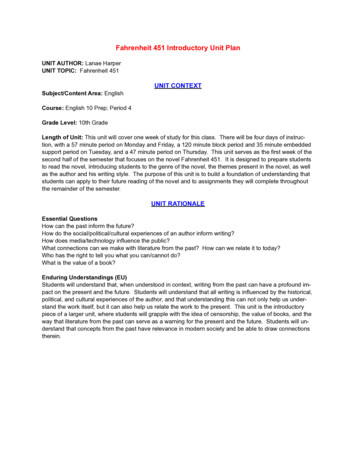
Transcription
A COURSE OF INSTRUCTION IN WOOD-CARVINGACCORDING TO THE JAPANESE METHODBY CHARLES HOLMEEDITOR OF " THE STUDIO "OFFICES OF 4 4 TIIE STUDIO '44 LEICESTER SQUARE, LONDON.
IJ APANESE WOOD-CARVING./ N Japan the art of wood-carving has probablybeen carried to a geater degree of perfectionthan in any other country in the world.Coincident with the progress of civilisation and thedevelopment of the arts in the West, the sculptureof marble and stone assumed an importance proportionate to the extent to which those materialswere employed in architecture.The physical characteristics of Japan—the prevalence of earthquakes and earth-tremors--whichprohibited the use of heavy materials for buildingpurposes, have, at the same time, ordained theemployment of wood as best adapted to resist theseseismic disturbances. Cottage and palace, barnand temple are, therefore, mainly constructed ofit, and wooden temples exist in Japan, built as farback as the ninth and tenth centuries of our era,which are still in sound condition, and exhibit ina far less degree the ravages of time than do thestone buildings of the same age in Europe.Whether wood or stone be the more " noble"material does not here concern us ; but that woodhas been rightly selected for use in Japan there canbe no manner of doubt ; and the result has been togive to the wood-carver a position in the artsequivalent to that enjoyed by the mason in the5
JAPANESE WOOD-CARVINGWest.As much respect is probably paid inJapan to the memory of the eminent wood-carver" Hidari " Jingoro, whose works may still beadmired and wondered at in many important buildings in that country, as is bestowed in Europe uponthe achievements of Pheidias, albeit that the essential characters of the great arts of Japan and Greeceare based upon widely differing Philosophies.European acquaintance with Japanese carving ischiefly confined to the small ornamental adjuncts topouch or dress known as Netsuke, to which so manyconnoisseurs of the curious and beautiful havewisely turned their attention in recent years. It iseasy to imagine the delight with which GrinlingGibbons would have gazed at some of these marvellous imitations of fungi, rats, and frogs, carved byhis own contemporaries in far-off Japan. But evenin the common articles of trade which are producedto-day in that country, the beauty and delicacy ofhandwork and the masterful use of the chisel areat times astonishing. It is not, however, untila visit to Japan reveals the works of the greatmasters in situ that it is possible to realise fullythe perfection to which the wood-carver's art hasthere attained. The massive gateways, the heavyroof bracketings, the panels and friezes on a grandscale, are carved with a force of sculpture,s. le6kJAPANESE WOOD-CARVINGexpression never exceeded in artistic power by anychiseller of stone in any age. These boldly conceived wood sculptures are evidence that thematerial, instead of detracting from the artisticvalue of the work, was in itself an advantage to theworker, who could obtain effects from it with fargreater freedom than would be possible from stone.The delight felt in contemplating them is, in fact,exactly akin to the pleasure aroused by the directtouches of a great painter which express so muchwith such little apparent effort.It is impossible to examine thoroughly much ofthe wood-carving of the Japanese without marvelling at the remarkable facility with which it appearsto have been executed. And this is noticeablenot only in the work of the great carvers, but alsoin the ornamentation of the commonest objects.Even the carved decoration on a penny paper-knife,although perhaps of the slightest, almost invariablybears evidence of having been executed by an adeptin his craft--one who could do better work if calledupon.From whence comes this facility ? Is it due tosome intuitive power, denied to us in the West,which enables the Japanese to draw and to carvewith the same ease that we learn to walk ? Ordoes it result from some more perfect method of7
el JAPANESE WOOD-CARVINGJAPANESE WOOD-CARVINGeducation than we are accustomed to ? The firstsuggestion may be rejected as improbable ? Whatare the facts about the second ?While upon a visit to Japan a few years ago, thewriter had the good fortune to visit the UniversityCollege in Tokio, where he was shown a series ofpractical object-lessons prepared by the master ofthe School of Wood-carving for the use of his pupils.Block after block was attentively inspected, and asthe lessons progressed, one following in a naturalsequence upon the preceding one, a system wasrevealed so practical, so full of careful thought, soperfect, as to impress him more than ever with thethoroughness of the people—a thoroughness shownalike in all they attempt, whether in the arts ofpeace or of war. The opportunities for learningtheir craft afforded to the old masters of woodcarving were, in all probability, very different fromthose now at the disposal of young Japan. In theold times the crafts were learnt in the workshop,very much in the European manner, and it is possible that each master had his own individual wayof instructing his apprentices. Of these methodswe know little, and, moreover, we shall probablynever be made fully acquainted with them. But ofthe system now in use at the Tokio University it isthe good fortune of the writer to be able to give8some detailed particulars. The system is one ofsuch general value that it might be studied toadvantage by all who are desirous of learning thisdelightful craft, as well as by those who have alreadymade partial progress towards mastering its intricacies. It might be described as the " 011endorff ofWood-carving." As taught in Japan, the fullcourse of lessons is supposed to occupy the studentthree years. The third year is, however, devotedto a series of advanced studies consisting of finishedworks, which have not the same technical interestto Europeans as the preliminary lessons.The illustrations of the lessons which here followhave been made by Mr. H. P. Clifford from the91
JAPANESE WOOD-CJIKV1NGactual carvings prepared in Tokio, and now in thepossession of the writer. These carvings are uponpieces of a soft wood, of the uniform size of sixinches square by about five-eighths of an inchthick.IOSET ITILL lessons comprised in this set arenaturally of a preliminary nature. Thestudent is first required to learn how tocarve a straight line—a by no means easy task. Inorder to guide the hand in cutting, however, linesare ruled upon the block. It is especially interesting to notice the fact that each lesson is based uponthe preceding ones, and that the beautiful patternsof Lesson 6 are merely a combination of the line,shown in Lessons 1 to 5.II
OSEN.—Horizontal lines. Cut with the gramof the wood, and consisting of combinationof the simplest forms of incised work.SET ILESSON2JusEN.—Vertical lines. Cut against the grainof the wood, but otherwise corresponding pre.cis,ely with the lines of Lesson [.
'j; 1(1;111i 1ii ,iil lir,r r ,4 , rr 1 r -----.- iii'llii ilii I li illi illilfI I III,drr , l, i treTfrviroi70' I,rar/17AVOMPArim.exr- ,,I111LimIII III IiiIIIIIII II NU S 155 ili,1SET IORIMAWASHI.—From Ori,Mawashi, to turn. This lesson isof the two preceding ones.1411 iLESSON 3to fold, anda combinationORI Komr.—From Ori, to fold, and Komi,to put into. A study of oblique lines andtriangles.I5
SET ILESSON 5SET ITAsuKI.—Intersecting lines. A simple butuseful lesson in the management of crossedlines.FRET AND KEY PATTERNS.—In this lesson,a combination of all the prQce,cling ones, thepatterns become somewhat more elaborate.
SET IIHE delightful diaper patterns given in thisset will be found extremely useful evento the skilled worker. The student isgradually led from straight lines and incisions of a;imple character to a slight modelling of the surface.The advance from stage to stage is so gradual as tohe scarcely perceptible, but steady progress is nevertheless being made, and a close study of the characteristics of each lesson will show with what skillthe designs have been selected.T,pg
KIRIKOMI SANKAKU. - Triangularincisions.In this the line-work observable throughout thelessons of Set I are absent.
SET IILESSON 2Overlapping triangularpatterns. A return to line wort:, showing somenew developments in fine ed oltitting,OIKAKE SANKAKU. —22pattern. Designs inwhich the incised work and fine edge-cuttingof the last two lessons are incorporated.ASANOHA.—Hemp-leaf23
1 1 1 1 1 1 1 11 1 11II111111,11111ft111111111111111111111111111 11 1111'SET IIlitI11SET IILESSON 4LESSON 51HIGAKI. Interlacing patterns. A similarlesson to the last, but dealing with obliquework.ISHIDATAM I.—Overlapping square patterns.A slight modelling or rounding of the faceoccurs here for the first time.—2L
THE first lessons in curved forms will nowbe set forth. The details of each patternand almost every line have their separatevalue as exercises. Thus, in the first two lessonsthe curves are so arranged as to give the maximumamount of instruction in the simplest manner. Itis intended that the hand, in following them, shouldSiE Ibe trained to make curves in all directions withequal facility. A thorough mastering of these earlylessons will be found by the student to be of1 mmense value to him when he commences to essayadvanced work. In the later lessons of this SetLESSON 6the first exercises for surface modelling on curved;:ones are given.itKAGOME.—Bamboo basket patterns. A moreelaborate development of the preceding lesson.2J27
SET III1ILESSON IJUKYOKUSFN.—Vertical curves. A preciselysimilar lesson to the first in Set I, save thatthe lines are curved instead of straight.
aSET IIILESSON 2ENKEI. — A circle. As in the precedinglesson, faint lines are first traced by thecompass as a guide to the carver.30SET IIILESSON 3TORI-TASUKI.— A curved pattern suggestiveof bird form. Simple incisions following welldefined geometric forms.31
111111111\,\SET IIILESSON .]Kumx-Kixo. — Tortoise-shell pattern. Thecentral portions of this design are slightlyrounded or modelled,32SET IIILESSON 5Kumx-Himo.—Braid pattern. Rounded interlacing forms with triangular incisions. Acombination of preceding lesson:,
SET IVNOTABLE stage of instruction is reachedin the lessons comprised in this Set.Hitherto the lines and curves have beenconfined to those of mathematical rigidity. Nolatitude has been given to the play of the hand.The necessity for the student to cultivate freehandis nowhere found to be more important than inwood-carving. There is a particular charm aboutthe perfect handling of the chisel which can scarcelybe overrated. Freedom of movement, togetherwith power of expression, are of the highest importance. Nothing denotes the master of the craftmore than the manner in which every cut isexecuted. Weakness, hesitancy, want of completesympathy between head and hand, soon makethemselves felt upon the work produced. TheJapanese carvers are renowned for the wonderfulcontrol they exercise over the chisel ; and there canbe little doubt that this is due in a large measure tothe great importance attached by them to freehandwork in all its phases.The progress of the freehand lessons in Set IVshould be very carefully examined. Lesson 1 beginswith deep triangular incisions, which are carvedforwards in a graceful curve until they terminate inAfine hair-like lines.Any hesitation or " niggling "35
JAPANESE WOOD-CARVINGon the part of the carver would be fatal to theproper production of such lines, and, indeed, closeattention and considerable practice will be foundnecessary in order to execute them satisfactorily.Lesson 2 is a further example of freehand work inwhich the experience gained in Lesson r will befound of the greatest use. Lesson 3 is scarcelymore than a variety of the preceding ones, but isremarkable for the fact that it introduces thestudent for the first time to the study of plant form.Lesson 4 is a delightful freehand study. The easysweeps of the tool and the delicacy and force of theincisions are admirably rendered. Lesson 5 teachesa still bolder form of cutting combined with a greaterdegree of surface modelling, and is a useful introduction to the final lesson, No. 6, of this Set. TheTOnteiye, upon which the last lesson is based, is aspecies of badge of circular form usually containinga combination of two or three comma-like patterns,and is often to be met with in Japanese ornamentation. In this case we have the crest of a wave rendered conventionally after the fashion of the badge.Its chief interest to the carver lies in the finesweeping lines of the pattern and the careful workrequired in the surface modelling.36SEN-Mo.—From Sen, to turn round, and Mo,hair. Curved lines of varying depth, turningboth to right and left.
i Ii l il i,1 niAii !; iii„liu,I1,,) Ill Hi 1,,,,,,„., 1II Ipi 11:1tilliiII IIwiI II,,,, ,,,,, ,,i1„„01 I]1' '[ 1 I 0 011 l i 1; [0 'It li 111,11 1 1 i I liti '11,,I a , i-r---iiIIIf:,--,',7- , ,, , r 1, 11,1II, , , ,,,,„ i Li,, , , ,„,, „ i ,it, .,,,,,,,,li, i1,IIN,,Curved strokes to right andleft. The varied depth of the cutting is toteach a free handling of theNAMI.—Waves.KIRI.NO-HA.—Leaves of the Kid. One sideof the leaf on the left hand is rounded on theouter edge.
SET IVLESSONSET IV4LESSON5KWAY0.—Flower and leaf forms. Based onthe preceding lesson, with the addition of amore elaborate modelling of the surface.Cnim-NuNo. — Scarf forms or " scatteredfabrics." A lesson in both shallow and deepcutting of free curved forms.440FJ
SET VWtzi-:.r IS'i. !3" !,"6 WI this Set the question of " Subjects" is first approached. The fourlessons consist of " Border " patterns suggested in some instances by the beautiful designs to be found in Japanese braids. At firstsight they appear to be almost a repetition ofstudies previously given ; but when carefullyexamined they will be found to present difficultiesof cutting not previously experienced. In the courseof the four lessons the student will find that he isrequired to practice every form and manner ofcutting hitherto learnt by him.NAMI ToMoYE.—The cresting of a wavearranged in the Temoye forms. The cuttingand modelling are based on the precedinglessons.4243
SET VLESSON ICHOKUSEN FUCHI MOY0.—Straight borderpatterns. Useful patterns of a comparativelysimple character.45
gMffitrM%',/,. 1 ,7'77./v" tatr.c„,% /7/ ,44/,e4//ro7/SET VLESSON 2MOY0.—Border patterns.The principal ornaments are derived from7 iparlese braid-work.KYOKUSEN FUCHISET VLESSON 3KYOKUSEN FUCHI.—Curved border patterns.Strength of handwork in the upper patternis contrasted with the delicacy of the lowerones.47
SET VITHESE exercises on " Plant Form " areof especial value, as they introduce thestudent more fully to freehand work, andto the splendid treatment of stems, leaves andflowers in which the Japanese are so singularlysuccessful. Breadth and simplicity are the distinguishing characteristics of these lessons, and thetreatment should be thoroughly mastered beforethe student proceeds to later studies.SET VKYOKUSEN OBI MOY0.—Curved girdle patterns. Full of delicate cutting and carefulsurface modelling.48ii
h PCSET VILESSON IHANA—Flower pattern. An ornament of flora.like character with simple surface modelling.51
SET VINOGUSA. — A plant. A more naturalisticrendering of floral form with simple butpleasant modelling.52SET VILESSON 2'ILESSON 3MIZU KusA.— Aquatic plant. A simple formof leaf and flower presenting brit few di:',cultiesto the carver.'53
SET VI54LESSON 4SET VILESSON 5YURI MOY0.—The lily form. A slightly moreelaborate study, the wavy outline requirincKwAjiTsu.—The fruit form. A free decorative rendering of a curious and unfamiliarcareful work.form.55
SET VIITHE whole purpose of the two Sets of7:---,----- VI---7-- --CSET VILESSON 6MOKUKWA.—The flower of a tree. Apparently representing a spray of the Tree Peony.The treatment of flower and leaves is excellent.56lessons which now follow is to familiarisethe student more and more with the useof his tools, and to show him a suitable treatmentof the varying forms and details of plant-life. Novery difficult tasks are imposed as the technique ofthe work is defined within the lines of precedinglessons. High-relief carving is, for the present, notattempted ; for there is so much to be learnt aboutthe proper presentment of the varied objects ofNature in the low-relief cutting hitherto practised--so much that is beautiful, so much that will befound of the greatest value in the serious work ofthe future—that the student is quite rightly keptfree from any new technical complications duringthe weeks of study which the present lessonsrepresent.And the tasks which are now set before him arecertainly delightful ones. These lessons of fruitand flowers are exquisite examples of the best oftheir kind, full of tender appreciation of the subtleforms of bud or of petal, of the rugosities of thestem or the veining of the leaf. It is in the delicateand almost loving regard for the finest traits ofNature that the Japanese craftsmen excel their confreres in the West, and it is, assuredly, in the more57
JAPANESE WOOD-CARVINGcareful study of every detail of Nature that thequality of our own art may be vastly improved.What more charming examples of a simple treatment of fruit and leaves could be desired thanLessons 3 and 4 of Set VII ? The character ofthe stems, the varied pose of the leaves, the growthand form of the fruit, are recorded so simply, andyet with such fine appreciation of the poetry whichsurrounds them in Nature, that they are worthy ofthe closest study. The lotus-leaf in Lesson 5 ofSet VII is essentially a study of light and shade.The characteristics of the leaf are shown by theshadows cast by the varying depth of the cutting.It is, in short, an example of impressionism in woodcarving, and is replete with pleasant suggestion,SET VIILESSON ITAMA. —The Sacred Jewel. A familiar objectto the student of old Japanese art-works.5859
SET VIILESSON 2SET V I ILESSON 3:Semi-naturalistically treated,midway in conventionality between the lastlesson and the next one.TAKE.—Fungi.6oKWABUTSU.—Fruit. A charming lesson infreehand cutting and low-relief modelling, thebut excellently rendered.fruit beingt)
1JSET VIII.EssoN 413113:M.—Grapes. Another delightful lessonfor the more advanced student. Note espe cially the freedom of the design.6 HASU and KAwAsEmi.—The lotus and thekingfisher. The lotus leaf, it will be observed,is treated in the impressionist manner.463
SET VIII0.N the whole of the lessons in this Set thecharacteristics of growth natural to eachplant are most carefully observed. Naturalism is treated in a purely decorative manner without loss of the specific charm with which Naturehas endowed each subject./LESSON 6IwA.—Rock form. The peculiar conventionobserved by the Japanese in the treatment ofrocks is here exemplified.64S
RAN.—An orchid. The ribbon-like leaves ofthis class of plant have been cleverly treatedto avoid monotony.
SASA.—A spray of bamboo. A very favouritesubject of Japanese carvers, and one that isopen to great variety of treatment.68TAKE—Bamboo stem. A bold and beautifultreatment of an interesting subject. Excellentin its simplicity.69
Kixu NO HA.—Leaves of the chrysanthemum.The cutting of the under side of ot,, oi tbr.leaves is especially worthy of70UME.—The plum tree. The rugged characterof the trunk acts as an excellent foil to themodelling of the flowers and buds.
SET IXTHE lessons comprised in this Set may beregarded as an introduction to carvingin relief. The deep recessed work of theearlier studies presents to the student some freshproblems, the mastering of which is of the highestimportance. Due comparison of each of the lessonswill show how thoroughly practical they are, andhow carefully the student is led by them throughthe maze of difficulties which beset him in theprogress of his studies.LESSON6KIKU NO HANA.—The chrysanthemum flower.A charming variety in the curves of the petalsand pose of the leaves.7273
SET IXLESSON IOai DAs n.—Outside folding. The upperright-hand portion is sunk to ti“, depth of?ths of an inch.75
11.1111 1111111,1 111111 I I 1 1111111taunti I 111SET IXLESSON 2Om Koran—Inside folding. The grouni issunk as in the last 1,24,;on, tlos foldcately modelled.76SET IXLESSON 3SHIKAKU.—Branch form. Deeply cut, theangles being very sharp and v.:U., greatprecision and care.77
r--I Il p11 1 I III 111111 1 .1 1,11.1,1.1 1 1IIPC1111 1111SET IX,1 1'1 ILESSON 4The same as the last, but with the branchesinterlacing at various depths and the edgesrounded off.7811 [ U lill11 1 1 1[11i1191140jLESSON 5SET IXKUMIHA.—Leafform. A further developleaves being deli-ment of the last 1(.:.1:- c.n1 ,cately 110 ft:110(1
SET XTSET IXLESSON 6HIS is a singularly beautiful and valuableseries of lessons. The technique peculiarto Japanese Carving is of especial interestwhen applied to the representation of birds. Probably no other method of carving could so simplyand yet so thoroughly express the characteristics ofwing and tail feathers as shown in Lessons 2 and 3 ;while in the final lesson (No. 6) there is exhibiteda simplicity of method and restraint in handling,combined with such perfect expression and suggestion of reality, that one is forced to admit that art ishere carried to a far higher level than in thelaboured and over-elaborated examples of similarsubjects in European work.S}nya.—Leaves and branches. The groundbeing deeply sunk necessitates especial care inthe management of the thin stems.8o81
form. Interesting as examples of the varied methods of d form. A study of wing andTail feathers. Cut with great precision anddelicacy.
ASET XLESSON 4TOBUTORI, or Him-O.—Flying birds. Thewings are cut with great sharpness, the bodiesbeing delicately rounded.Sumo CH .—Birds on tree. The design ishere shown in relief, the groundwork being cutaway.
SET XI-ISET XLESSON 6TORI.—Bird. Shown in relief, the groundwork being cut away. The feet are exquisitelyrepresented in the original carving.88Mm-NLessons 3, 4, and 5 of this Set, the value ofexpression in purely decorative work isadmirably set forth. We may learn fromthem how the beauty of conventional design maybe largely augmented by the spirit infused into it.Vapour, water and fire have each their own characteristics over and above the mere forms with whichwe associate them. That it is possible to express inform even such abstract ideas as softness, strength,and vigour is here admirably proved. Indeed, it isone of the greatest charms of these lessons that notonly do they teach us much of pure technical value,but they enable us to see that beyond this there isa quality of pure art that ennobles the work performed. In these simple studies it may be that weget but occasional glimpses of this high quality ;but if we turn to the great work of the Japanesecraftsmen we can more fully realise the perfectionto which that quality has attained in their hands.We have no illustrations for the sixth series, completing the second year of instruction, as we areinformed that no " set " studies are given at thatperiod of education. The lessons given by theJapanese master to his students after they havepassed through the course here illustrated are morein the nature of completing objects, such as Raanina, ,9
JAPANESE WOOD-CARVINGor the open-work panels used as a sort of friezeround Japanese rooms.It is considered that the student who has passedthrough this course of lessons is sufficiently trainedto permit him to undertake more practical work.He has been led step by step from the simplestpossible lines through freehand, to the delineationof natural forms of both vegetable and animalcharacter. There is, of course, work of a muchmore advanced nature still to master, but if he hasbeen thoroughly grounded in the lessons alreadygiven, he should now be in a position to take anindependent course. He has, as it were, beenshown the way ; and it is well, perhaps, that heshould now cast aside the leading-strings andSET XILESSON I become self-reliant.Hossu.—A brush of long white hair, frequently carried by Buddhist priests.9091
-AP. C.SET XILESSON 2HANE.—Feathers. The ground is sunk inchin the centre, permitting the feathers to be cuton varying planes.92ISET XILESSON 3Kumo.—Cloud form. A high-relief study ofconventional character. Very softened edges.91
el-.ma - MIIIISET XILESSON 4Mizu.—Water form. A conventional rendering of the cresting of a wave. Boldly treated.94SET XILESSON 511.—Flame form. A remarkably crisp and igorous treatment in characteristic Japaneseoutir(JItion.95
CSET XIHORA.relief,96LESSON 6— A conch-shell, Carved in high-the ground being cut away nearly .114.1f
the perfection to which the wood-carver's art has there attained. The massive gateways, the heavy roof bracketings, the panels and friezes on a grand scale, are carved with a force of sculpture,s. le 6 JAPANESE WOOD-CARVING expression never exceeded in artistic power by any chiseller of stone in any age. These boldly con-










